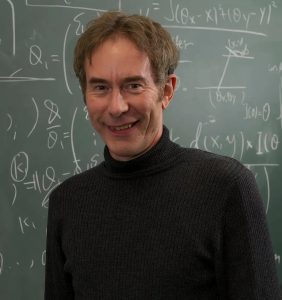Ian Shipsey Biography
Ian Shipsey (1959–2024) was a renowned experimental particle physicist and the Henry Moseley Centenary Professor of Experimental Physics at the University of Oxford, where he also served as the Head of the Department of Physics from 2018 until his death in October 2024. Shipsey made groundbreaking contributions to particle physics, particularly in the study of heavy quarks and the Higgs Boson, and played a key role in the development of the pixel detector used in the discovery of the Higgs Boson at CERN in 2012.
Born in London, Shipsey completed his undergraduate studies at Queen Mary University of London in 1982 and earned his PhD from Edinburgh University in 1986. His early career saw him work at leading institutions in the United States, including Syracuse University and Purdue University, before he joined Oxford in 2013. Shipsey was deeply involved in international collaborations such as the Large Hadron Collider (LHC) and the Vera C. Rubin Observatory’s Legacy Survey of Space and Time (LSST), helping to advance our understanding of dark matter and dark energy.
Despite being profoundly deaf since 1989, Shipsey’s cochlear implant allowed him to regain partial hearing, which led him to become an advocate for cochlear implant technology, delivering over 100 talks on the subject. His dedication to science and to improving access for disabled students and colleagues was widely recognized, and he was elected a Fellow of the Royal Society in 2022, among other honors.
Shipsey passed away suddenly in October 2024, leaving behind a legacy of scientific achievement and a profound impact on the global physics community.
Ian Shipsey Age
Ian Shipsey was 65 years old when he passed away on October 7, 2024. He was born in 1959.
Ian Shipsey Hometown
Ian Shipsey hailed from Walthamstow, East London, United Kingdom.
Ian Shipsey Height
Ian Shipsey stood at an average height of 5 feet 8 inches (1.73 meters).
Ian Shipsey Educational Background
Ian Shipsey’s educational journey began in Walthamstow, East London, where he attended a local comprehensive school. Despite the school not having a trained A-level physics teacher, Shipsey’s passion for science led him to pursue higher education. He went on to attend Queen Mary University of London, where he obtained his undergraduate degree in 1982. Following this, he pursued a PhD in experimental particle physics at Edinburgh University, graduating in 1986.
During his PhD studies, Shipsey worked on the CERN NA31 experiment, marking the beginning of his involvement with particle physics at the prestigious European laboratory.
Ian Shipsey Career

Ian Shipsey was a globally recognized experimental particle physicist whose work greatly advanced our understanding of the universe’s fundamental particles. His career spanned over four decades, during which he contributed to major international scientific collaborations, including work on the Higgs boson and dark energy. Shipsey’s scientific impact, leadership, and dedication to education and outreach have left a lasting legacy in the field of physics.
Early Career and Contributions to Particle Physics
Ian Shipsey began his career after completing his PhD at Edinburgh University in 1986, primarily working on the CERN NA31 experiment. This early experience marked the start of his long involvement with CERN, one of the world’s most important centers for particle physics research. In his early career, Shipsey focused on understanding why matter survived after the Big Bang, a fundamental question in particle physics. He moved to the United States, where he held academic positions at Syracuse University and Purdue University, continuing his work on subatomic particles and contributing to key discoveries related to quarks.
Work at Cornell University and Contributions to Quark Research
While at Cornell University, Shipsey made significant strides in the study of heavy quarks, specifically charm and bottom quarks, which are crucial to understanding the fundamental forces that govern particle interactions. His work with the CLEO and CLEO-c experiments was instrumental in making precise measurements of rare decays of particles containing these quarks. Shipsey played a leading role in these experiments, which confirmed predictions of the Standard Model and ruled out alternative theories. His research also explored the suppression of the beauty quark-antiquark state, providing evidence for the existence of the Quark-Gluon Plasma, a new state of matter.
Read Also: Blayne Alexander Wikipedia, Biography, Age, Parents, Husband, Wedding, Career, Net Worth, Children
Leadership in the Discovery of the Higgs Boson
Shipsey’s work reached a major milestone with his involvement in the discovery of the Higgs boson at CERN in 2012. As a key member of the team, Shipsey contributed to the development of the pixel detector used in the ATLAS experiment at the Large Hadron Collider (LHC). This technology was critical in identifying the Higgs boson, a particle that explains how other particles acquire mass. The discovery of the Higgs boson was a major scientific breakthrough, confirming a central element of the Standard Model of particle physics.
Contributions to Dark Energy and the Vera C. Rubin Observatory
Beyond the Higgs boson, Shipsey was also deeply involved in research aimed at understanding dark energy, the mysterious force driving the accelerated expansion of the universe. He pioneered the Department of Energy’s involvement in the Vera C. Rubin Observatory’s Legacy Survey of Space and Time (LSST), which is set to make groundbreaking discoveries in astronomy. The LSST camera, the largest ever built for astronomy, is expected to provide new insights into dark energy, making definitive measurements of this cosmic force.
Advocacy for Quantum Technologies and Fundamental Physics
Ian Shipsey played a central role in the development of quantum technologies in the UK. He was instrumental in the creation of UK Research and Innovation’s Quantum Technologies for Fundamental Physics Programme (2018-2020), which sought to apply quantum computing and simulation to problems in fundamental physics. His pioneering work in this field led to the establishment of the Quantum Computing and Simulation Hub, positioning the UK as a global leader in quantum research.
Academic Leadership at Oxford University
In 2013, Ian Shipsey returned to the UK to join Oxford University as the Henry Moseley Centenary Professor of Experimental Physics. He was elected as the Head of the Department of Physics in 2018 and re-elected for a second term in 2023. During his tenure, Shipsey significantly expanded the department’s public science initiatives and was a strong advocate for inclusion, particularly for disabled students and colleagues. His leadership extended to overseeing critical research projects at Oxford, including the AION project, which explored ultralight dark matter and gravitational waves.
Contributions to Education and Public Outreach
Ian Shipsey was passionate about sharing his love for science with the public and young people. Despite losing his hearing in his late 20s, he continued to work as a physicist and eventually regained partial hearing through a cochlear implant. His personal experience led him to become a strong advocate for hearing-impaired individuals and the use of cochlear implants. He gave over 100 public talks on the subject and created YouTube videos to raise awareness about this life-changing technology.
Ian Shipsey’s Death
Ian Shipsey passed away suddenly on October 7, 2024, at the age of 65. His death was unexpected and sent shockwaves through the scientific community. Shipsey had made significant contributions to the field of particle physics, notably his work on the Higgs boson and his pioneering research on dark energy. At the time of his passing, he was deeply involved in leading cutting-edge scientific projects, such as the Vera C. Rubin Observatory’s Legacy Survey of Space and Time (LSST) and quantum technology initiatives.
Ian Shipsey Awards, Honors and Recognitions
Ian Shipsey received several prestigious awards and honors throughout his career. Some of the notable ones include:
- Fellow of the Royal Society (FRS) – Elected in 2022, one of the highest honors in UK science.
- Chadwick Medal and Prize (2019) – Awarded by the Institute of Physics for outstanding contributions to particle physics.
- Fellow of the American Physical Society (APS) – Recognized for his distinguished contributions to particle physics.
- Fellow of the American Association for the Advancement of Science (AAAS) – Honored for his work in advancing science.
- Honorary Fellowship of the Institute of Physics (IoP) – Acknowledged for his significant contributions to physics.
- Induction into Purdue University’s “Book of Great Teachers” (2004) – One of Purdue’s highest honors, recognizing excellence in teaching.
- Life Fellow, Purdue University Teaching Academy (1998) – An award recognizing his exceptional teaching contributions.
- Charles B. Murphy Award for Outstanding Undergraduate Teaching (1998) – Purdue’s highest undergraduate teaching award.
- Phi Eta Sigma National Freshman Student Honor Society, Honorary Life Member (2010) – Awarded for his contributions to teaching.
- Alpha Lambda Delta National Student Honor Society, Honorary Life Member (2010) – Another teaching recognition awarded in the U.S.
Ian Shipsey Wife and Children
Ian Shipsey was married to Professor Daniela Bortoletto, an Italian particle physicist. The couple met during their time at CERN and shared a long-lasting relationship of over 30 years. They had one daughter, Francesca Shipsey.
Ian Shipsey Net Worth
Ian Shipsey had an estimated net worth of £5 million at the time of his passing.
FAQs
Who was Ian Shipsey?
Ian Shipsey was a renowned experimental particle physicist, known for his contributions to the study of quarks, the Higgs boson, and dark matter. He was the Head of the Department of Physics at the University of Oxford until his death in 2024.
What are Ian Shipsey’s major scientific achievements?
Shipsey played a critical role in the discovery of the Higgs boson at CERN in 2012. He also contributed to the development of the pixel detector used in the Large Hadron Collider and led work on the Vera C. Rubin Observatory’s Legacy Survey of Space and Time (LSST).
Where did Ian Shipsey work during his career?
Shipsey worked at major institutions including Purdue University, Syracuse University, and Oxford University. He was also heavily involved with research at CERN and Fermilab.
What contributions did Ian Shipsey make to quantum technology?
Shipsey was instrumental in the development of the UK’s Quantum Technologies for Fundamental Physics Programme, applying quantum computing to solve fundamental physics questions.
Was Ian Shipsey involved in public outreach?
Yes, Shipsey was a strong advocate for public science education and disability access. He delivered numerous talks on cochlear implants and their impact, drawing from his own experience of regaining hearing.
What awards did Ian Shipsey receive?
Among his many honors, Shipsey was elected a Fellow of the Royal Society, the American Physical Society, and the American Association for the Advancement of Science. He also received the Institute of Physics’ Chadwick Medal in 2019.
What role did Ian Shipsey play in the Vera C. Rubin Observatory project?
Shipsey was a pioneering figure in the Vera C. Rubin Observatory’s LSST project, which aims to make definitive measurements of dark energy. He played a leading role in developing the observatory’s large camera.
What is Ian Shipsey known for in particle physics?
In addition to his work on the Higgs boson, Shipsey made critical contributions to the study of heavy quarks, particularly through his leadership of the CLEO and CMS experiments.
